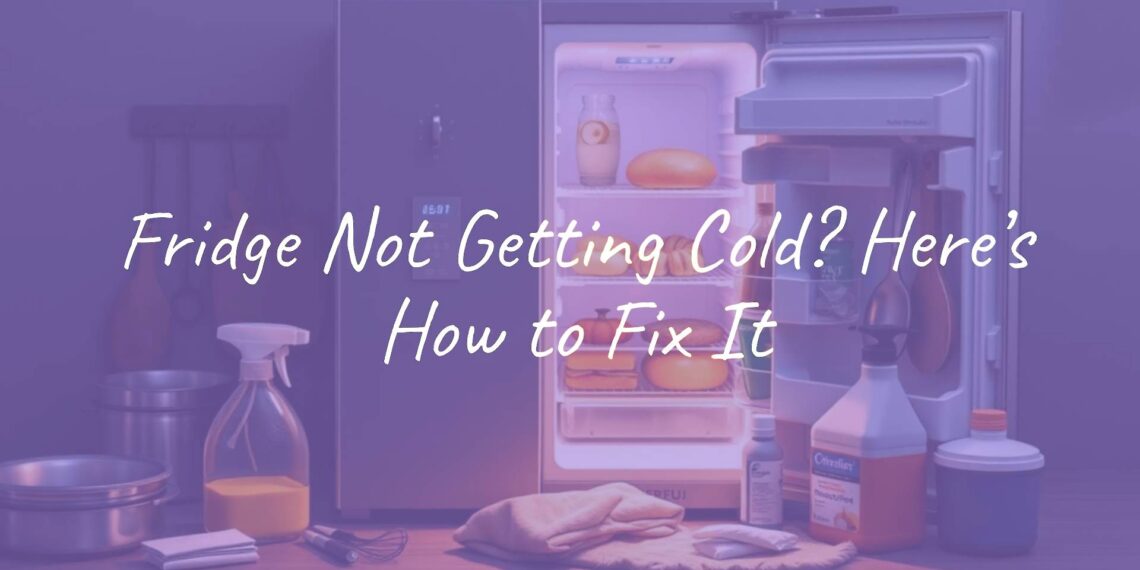Is your fridge not keeping things cool? A warm refrigerator can spoil your food, waste your money, and cause plenty of stress. But don’t worry just yet-a lot of cooling problems can be fixed with basic checks or simple repairs. From dusty coils to more complicated mechanical issues, knowing the usual causes of a fridge that isn’t cold helps you bring it back to normal. Below, we’ll go over the most common reasons your fridge isn’t working as it should and what you can do about it.

Why Isn’t My Fridge Cooling?
Your refrigerator is one of the most important appliances at home, making sure your food stays fresh by keeping it cold enough to slow bacteria growth. When it stops working properly, it can feel like a big problem. Understanding how your fridge cools will help you figure out why it can stop doing its job.
Your fridge cools using a loop: the refrigerant gas gets compressed, heats up, and then moves through condenser coils (these are usually at the back or beneath the fridge) to release heat. As it cools, the gas turns back to a liquid and passes through an expansion valve where it gets cold and becomes a low-pressure vapor. This cold vapor moves through the evaporator coils inside the fridge and freezer, soaking up heat from the air inside. That heat leaves with the refrigerant, which turns to gas again and repeats the cycle, keeping the inside of your fridge cold.
What’s the Right Fridge Temperature?
To keep your food safe and fresh, your fridge should stay between 32ºF and 40ºF (0°C to 4°C). The FDA says 40°F (4°C) or lower is best. When it’s any warmer, bacteria grow faster, and your food will spoil sooner and may start to smell.
How Does a Fridge Make Things Cold?
Your fridge uses science to keep food cold. It doesn’t make cold air-it removes heat from inside. The compressor moves a chemical called refrigerant around in a loop. It gets hot and pressurized, cools off and becomes liquid, then expands in the evaporator where it gets very cold. This cold refrigerant goes through coils inside the fridge, soaking up heat from food and air. It then restarts the cycle, carrying heat outside the fridge as it does its job over and over.

What to Check First When a Fridge Stops Cooling
If your fridge isn’t cooling, don’t panic. Many times the problem is simple and easy to fix-no need to buy a new fridge or call for repairs yet. Start with these basics:
Is Your Fridge Plugged In and Powered?
This might sound simple, but make sure your refrigerator is plugged in tightly to a working outlet. Sometimes a loose cord or tripped circuit breaker will cut off all power. Check the breaker box and flip the switch if needed. If your fridge light won’t turn on, the power might be the problem.
Are the Temperature Controls Set Correctly?
Check to make sure no one has bumped the thermostat. It should be set between 32ºF and 40ºF (0°C-4°C) for the fridge and around 0°F (-18°C) for the freezer. Sometimes these settings are accidentally changed. It may take up to 24 hours after changing the settings for the fridge to become properly cold, so give it time if you make any adjustments.
Does the Fridge Door Seal Properly?
If the door doesn’t close all the way, warm air comes in, and the fridge can’t stay cold. Check that nothing inside is blocking the door. Also, inspect the rubber gasket around the door-if it’s dirty, sticky, or has cracks, cold air can escape. Try the paper test: close the door on a piece of paper. If it pulls out easily, the seal might be bad. Clean the gasket with warm, soapy water or replace it if it’s damaged.

Common Reasons a Fridge Doesn’t Get Cold
Past the basics, several typical problems can keep your fridge from staying cold:
Dirty or Blocked Condenser Coils
If the coils on the back or bottom of your fridge are covered in dust or pet hair, heat can’t escape and your fridge won’t cool as well. Cleaning these coils about twice a year (or more if you have pets) can quickly fix this issue and help your fridge last longer. Just unplug it before cleaning.
Door Seals (Gaskets) Are Faulty or Dirty
The soft rubber seal around the fridge door keeps the cold in and the warm air out. If the seal is torn, cracked, or dirty, it can’t do its job. Check for damage and clean as needed. If the seal still doesn’t grip after cleaning, it may be time to replace it.
Air Vents Are Blocked
For your fridge and freezer to stay the same temperature throughout, cold air must flow through vents inside. Make sure food or containers aren’t blocking them. If there’s frost or ice blocking the vents, defrost your fridge to clear it.
Poor Food Arrangement
If your fridge is too full or food is packed tight near the vents, cold air can’t move around. Leave some space between items so air can flow freely, which helps everything stay at the right temperature.
Broken Condenser or Evaporator Fan
Fans help move cold air inside and cool the compressor. If you hear buzzing or notice either compartment is warm, a fan may be broken. This repair usually needs a professional.
Compressor Problems
The compressor pushes the refrigerant around, making the cooling process work. If it’s broken or very hot to the touch, the fridge won’t cool. Compressor repairs should be done by a trained technician since they are complex and often expensive to replace.
Electrical or Circuit Board Issues
The circuit board controls your fridge’s parts. If it fails, the fridge might not cool. Fixing wiring or circuit boards is dangerous and should be done by a technician.
Not Enough Space Around the Fridge
Your fridge needs room to get rid of heat. If the fridge is pressed against walls or cabinets, it can’t cool properly. Leave at least half an inch on each side and an inch behind the fridge for better airflow.
| Possible Cause | How to Check | Solution |
|---|---|---|
| Power supply issue | Light/Display not working | Plug in and reset breaker |
| Dirty condenser coils | Visual inspection | Unplug and clean coils |
| Blocked vents | Check for items/ice by vents | Move food/defrost if needed |
| Faulty door seal | Paper test, look for cracks | Clean or replace gasket |

Why Is the Fridge Warm but the Freezer Is Still Cold?
Sometimes, the freezer stays frozen while the fridge isn’t cold. In most fridges, the freezer makes all the cold air, sending it to the fridge through vents. If the freezer works but the fridge doesn’t, the main cooling parts are probably okay, but there’s a problem with air not moving into the fridge part.
Common Reasons for This Problem
- Evaporator Fan Problem: If the fan that pushes cold air around fails, chilled air won’t reach the fridge. Listen for fan noise or test with the door switch pressed in.
- Blocked Vents or Dampers: Food, ice, or a stuck flap can stop cold air from moving from freezer to fridge.
- Defrost System Trouble: If the defrost heater or thermostat fails, ice can build up and block air flow.
- Broken Thermistor (Temperature Sensor): A faulty sensor can trick the fridge into thinking it’s cold enough, stopping more chilling.
- Circuit Board Issue: If the board wrongly manages fan speed or vent positions, temperatures can become uneven.
How to Find Airflow Problems
- Listen for the Evaporator Fan: Open the freezer (and press the door switch if needed). If you don’t hear the fan, it might be broken.
- Look at the Vents: Check for ice or food blocking air vents in both compartments.
- Check for Ice Build-Up: If there’s a lot of frost or a solid block of ice, the defrost system could be the issue. Unplugging the fridge for 24 hours to melt the ice can restore airflow temporarily.
- Inspect the Damper: Make sure the damper between compartments isn’t stuck closed.
If you can’t find the problem or feel unsure about opening up your fridge, it’s smart to call a service professional.
How to Troubleshoot a Warm Fridge: A Simple Guide
You can solve many fridge problems yourself by following a few easy steps. Here’s what to do:
Clean the Condenser Coils
Unplug the fridge. Pull it out if the coils are behind, or remove the cover at the bottom front if needed. Use a vacuum and a soft brush to remove dust and dirt. Plug the fridge back in and watch for improvement over the next 24 hours.
Check and Fix the Door Seals
Inspect the rubber seals for any damage or dirt. Clean them with warm, soapy water. Use the paper test: if a slip of paper pulls out easily, replace the seal with one made for your model.
Check the Temperature Controls
Make sure the dials or digital settings for both fridge and freezer are at the right temperatures: 32-40°F for the fridge, 0°F for the freezer. Adjust if needed and allow a day to see changes.
Make Sure Air Circulates Properly
Don’t pack food so tightly that it blocks vents, and leave space between items. Move the fridge to ensure there’s space around it for heat to escape.
Reset the Fridge
Sometimes, unplugging the fridge for 5-10 minutes helps fix electronic issues. After plugging it back in, let it run for a full day without opening it too much and see if it cools properly.
When Do You Need a Fridge Repair Technician?
Some problems are too hard or risky to fix without help. If basic troubleshooting doesn’t help, it’s time to call a repair technician, especially for:
- Still No Cooling but Fans Run: Could mean a refrigerant leak, bad compressor, or blocked lines-these are complicated fixes.
- Compressor Stops or Runs Hot: Compressors can be dangerous and costly to fix on your own.
- Loud or Strange Noises: Grinding, banging, or buzzing could mean problems with the compressor or fans.
- Lots of Frost (on a frost-free fridge): This usually means the defrost system is broken.
- Possible Refrigerant Leak: Don’t touch! If you smell a weird chemical or hear hissing, get a repair person right away.
- Electrical Problems or No Power at All: If lights and fans won’t turn on but the outlet works, it could be an internal wiring or board problem.
- Stubborn Issues: If you’ve done all basic checks and nothing works, a professional can quickly diagnose and fix the problem.
Why Avoid DIY Repairs for Complex Problems?
- You Might Damage the Fridge Further: Without training, you could break other parts and make repairs even more expensive.
- Risk of Injury: Fridges have dangerous electrical parts and chemicals inside.
- Voiding the Warranty: Many warranties become useless if you do repairs yourself.
- Fire and Safety Risks: Repairs to electronics or refrigerant systems can cause serious hazards if not done right.
Professional repair technicians have the right training and tools to fix your fridge safely and correctly.

Frequently Asked Questions About Fridge Cooling Issues
Worried about your fridge warming up? Here are some common questions and answers:
What Usually Causes a Fridge to Stop Cooling?
The most common reasons for poor cooling are dirty condenser coils, blocked air vents, or a worn or dirty door gasket. Sometimes, the problem is as simple as someone changing the temperature setting by accident or a power supply that’s been interrupted. More serious causes like broken fans, failed compressor, or refrigerant leaks need a professional to fix.
How Can I Tell if My Compressor Is Bad?
If your fridge runs all the time but doesn’t get cold, if the compressor gets very hot, or if it makes loud or odd noises, your compressor might be the issue. If your circuit breaker trips often, that can be a clue too. Compressor repairs are tricky, so let a trained technician handle it.
Is Food Safe to Eat If the Fridge Gets Warm?
Food like meat, dairy, and leftovers should not be at more than 40°F (4°C) for over two hours (or more than one hour if your room is over 90°F/32°C). Bacteria can grow quickly even if food looks and smells fine, so if your fridge has been warm too long, throw away the perishable items to be safe. When unsure, it’s best to throw it out and avoid getting sick.
















![What to with Scrap Metal? [infographic]?](https://facts-homes.com/wp-content/uploads/2019/07/645413-POPYOV-391-120x86.jpg)





